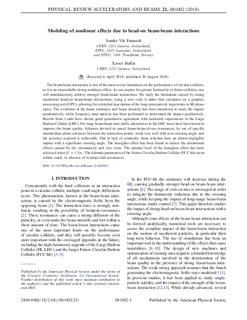| dc.contributor.author | Furuseth, Sondre Vik | |
| dc.contributor.author | Buffat, Xavier | |
| dc.date.accessioned | 2019-09-06T07:27:46Z | |
| dc.date.available | 2019-09-06T07:27:46Z | |
| dc.date.created | 2018-11-22T11:01:12Z | |
| dc.date.issued | 2018 | |
| dc.identifier.citation | Physical Review Accelerators and Beams. 2018, 21 (8) | nb_NO |
| dc.identifier.issn | 2469-9888 | |
| dc.identifier.uri | http://hdl.handle.net/11250/2612854 | |
| dc.description.abstract | The beam-beam interaction is one of the most severe limitations on the performance of circular colliders, as it is an unavoidable strong nonlinear effect. As one aspires for greater luminosity in future colliders, one will simultaneously achieve stronger beam-beam interactions. We study the limitations caused by strong incoherent head-on beam-beam interactions, using a new code (cabin) that calculates on a graphics processing unit (GPU), allowing for a detailed description of the long-term particle trajectories in 6D phase space. The evolution of the beam emittance and beam intensity has been monitored to study the impact quantitatively, while frequency map analysis has been performed to understand the impact qualitatively. Results from cabin have shown good quantitative agreement with dedicated experiments in the Large Hadron Collider (LHC). For large beam-beam tune shifts, alternatives to the LHC tunes have been found to improve the beam quality. Schemes devised to cancel beam-beam driven resonances, by use of specific intermediate phase advances between the interaction points, work very well with zero crossing angle, and the accuracy required is achievable. Due to lack of symmetry, these schemes have an almost negligible impact with a significant crossing angle. The hourglass effect has been found to reduce the detrimental effects caused by the chromaticity and vice versa. The optimal level of the hourglass effect has been achieved when β∗=1.5σs. The ultimate parameters of the Future Circular Hadron Collider (FCC-hh) seem within reach, in absence of residual odd resonances. | nb_NO |
| dc.language.iso | eng | nb_NO |
| dc.publisher | American Physical Society | nb_NO |
| dc.rights | Navngivelse 4.0 Internasjonal | * |
| dc.rights.uri | http://creativecommons.org/licenses/by/4.0/deed.no | * |
| dc.title | Modeling of nonlinear effects due to head-on beam-beam interactions | nb_NO |
| dc.type | Journal article | nb_NO |
| dc.type | Peer reviewed | nb_NO |
| dc.description.version | publishedVersion | nb_NO |
| dc.source.volume | 21 | nb_NO |
| dc.source.journal | Physical Review Accelerators and Beams | nb_NO |
| dc.source.issue | 8 | nb_NO |
| dc.identifier.doi | 10.1103/PhysRevAccelBeams.21.081002 | |
| dc.identifier.cristin | 1633652 | |
| dc.description.localcode | Published by the American Physical Society under the terms of the Creative Commons Attribution 4.0 International license. Further distribution of this work must maintain attribution to the author(s) and the published article’s title, journal citation, and DOI. | nb_NO |
| cristin.unitcode | 194,66,20,0 | |
| cristin.unitname | Institutt for fysikk | |
| cristin.ispublished | true | |
| cristin.fulltext | original | |
| cristin.qualitycode | 1 | |

